

|
|
 |
 |
 |
 |

Ryote-dori
TENCHI-NAGE
Demonstrated and explained by
Kanetsuka Sensei
|
|
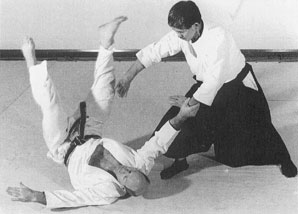 |
|
Ten, meaning 'heaven' and chi, meaning 'earth', give this technique an unusually poetic name. The throw is so called because Tori unbalances Uke with one arm swinging upwards and the other downwards. The most basic form, shown here, is with ryote-dori (in this case from ai-hanmi stance). Tenchi-nage is essentially a form of Kokyu-nage. Is is a very useful exercise in te-sabaki (the use of the hands in Aikido movement) and for tai-sabaki generally. The same principles of movement are used in many other techniques.
1. Omote (to the front)
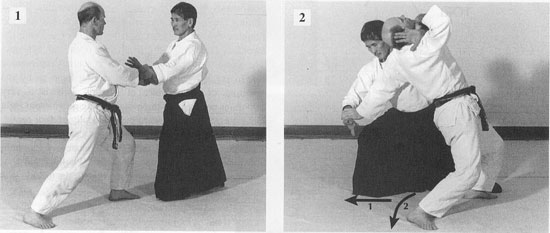
Photos 1-4: Tori is in hidari ai-hanmi stance. His arras form a kamae (defensive) posture with the hands open in front of his centre, pointing directly at Uke, as with holding a sword in chu-dan. Tori's left hand cuts up with the same feeling as in the suwari-waza kokyu-ho exercise, the wrist rotating inwards and the thumb pointing towards his nose as the hand rises. Do not open the arm-pit and lift the elbow too high. Keep the shoulders relaxed. Energy should flow from your back (right) foot through your centre to the fingers of your left hand.

 With ayumi-ashi, Tori slides his right foot forwards,: keeping his knees well bent, so that it finishes well to the right of Uke to form sankaku (a triangle) with Uke's left] and right heels. In this movement Tori's right foot slides at an angle of about 30° from Uke's attacking line. (You must take care not to finish too close to your partner, nor too far to the side. It will depend on the situation and the reaction of your partner.) Then Tori slides his left foot forwards, the left ankle coming close to the right ankle (knees bent), as the left foot changes direction towards Uke's right heel.
With ayumi-ashi, Tori slides his right foot forwards,: keeping his knees well bent, so that it finishes well to the right of Uke to form sankaku (a triangle) with Uke's left] and right heels. In this movement Tori's right foot slides at an angle of about 30° from Uke's attacking line. (You must take care not to finish too close to your partner, nor too far to the side. It will depend on the situation and the reaction of your partner.) Then Tori slides his left foot forwards, the left ankle coming close to the right ankle (knees bent), as the left foot changes direction towards Uke's right heel.
The movement of Tori's right hand during this manoeuvre needs careful study. The right hand swings downwards but also forwards in an action that is like cutting Uke's centre, the wrist turning inwards and the thumb downwards (rather like the action of drawing the sword in Iaido), and the hand kept open and dynamic. The 'earth' element of Tenchi-nage is actually represented not so much by the downward cutting hand as by the lowering of your centre of gravity. This is a very important point. After the initial cutting down, your right hand is not moving forward independently of your centre. It is moving forward because your centre is moving forward. In other words, the distance between your centre; and your lower hand remains the same (Photos 2 and 4).
Once Uke is unbalanced as in Photo 4, the technique is all but complete.
|
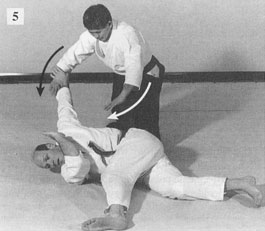 |
|
Photo 5: As Uke falls, Tori continues moving and keeping close contact. Note that Tori's arms have now the same shape and feeling as at the end of the suwari-waza kokyu-ho exercise. They form an incomplete circle, the fingers pointing towards Uke. Maintain zanshin.
|
2. Ura (with tenkan) |
|
 Photo 6: From ai-hanmi stance, Tori takes a step forward with a feeling of attacking Uke's centre and assumes gyaku-hanmi.
Photo 6: From ai-hanmi stance, Tori takes a step forward with a feeling of attacking Uke's centre and assumes gyaku-hanmi.
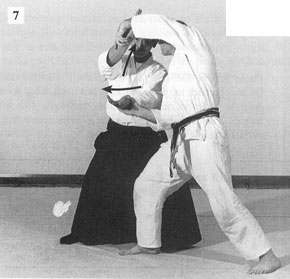 Photo 7 & 8: Avoiding Uke's attack, Tori takes a small step aside with his left foot. His right hand cuts up vertically on the inside of Uke's wrist. With his left arm - the hand, palm upwards, staying in front of his centre -he draws Uke forwards. This movement is identical with the beginning of haishin-undo to the rear. Then continuing to unbalance Uke, Tori makes tenkan, sliding his right foot to the rear. As you make this movement, it's important to keep your hands in front of you. Do not pull your upper hand to the side: it should finish more or less in front of your eyes. Turn the wrist inwards as you cut up.
Photo 7 & 8: Avoiding Uke's attack, Tori takes a small step aside with his left foot. His right hand cuts up vertically on the inside of Uke's wrist. With his left arm - the hand, palm upwards, staying in front of his centre -he draws Uke forwards. This movement is identical with the beginning of haishin-undo to the rear. Then continuing to unbalance Uke, Tori makes tenkan, sliding his right foot to the rear. As you make this movement, it's important to keep your hands in front of you. Do not pull your upper hand to the side: it should finish more or less in front of your eyes. Turn the wrist inwards as you cut up.
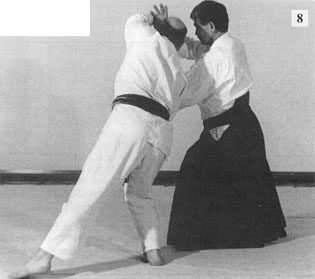
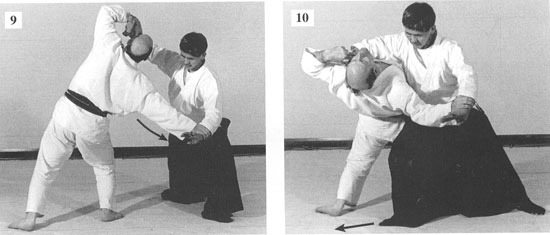
|
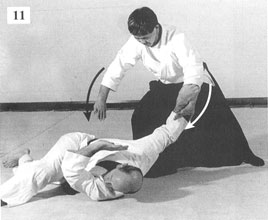 |
|
Photo 9: Now Tori slides his left foot to Uke's right side. Do not approach too close to Uke at this point. Keep good maai in order to maintain tension and keep Uke off balance. This movement is the same as in the omote form of the technique (Photo 2).
Photos 10 and 11: The action continues identical with that of the omote form shown in Photos 5 & 6.
|
|
 |
| |
|
 |
  |
 |
